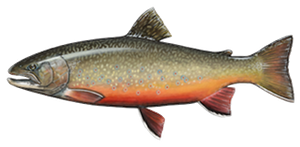Pennsylvania coldwater habitat restoration program
Goals
Throughout Pennsylvania, native brook trout are at risk. Pressures from poor land management, natural resource development, and other problems have impacted fish populations and reduced fishing opportunities throughout the state.
In addition to improving instream habitat, a major emphasis of this initiative is to identify and address stream crossings, such as road culverts, that act as barriers for fish passage. TU got its start on planning and implementing fish habitat improvement projects in 1998 in the Kettle Creek watershed of northcentral Pennsylvania.
While TU continues to focus a great deal of its efforts in the Kettle Creek watershed, it is expanding its reach to other high priority coldwater streams in central and northcentral Pennsylvania. TU also works to educate the next generation of coldwater conservation stewards through in-classroom and field programs for grades K-12.
Tactics
TU’s tactics for improving Eastern brook trout habitat is accomplished by improving sediment drainage from dirt and gravel roads, planting trees and shrubs along streams, stabilizing streambanks, and installing fish habitat structures.
Since the extent of the culvert problem is not known in TU’s targeted watersheds (nor across much of Pennsylvania), one of TU’s first big tasks has been to initiate a culvert inventory to help determine which culverts are most in need of repair or replacement. Now that surveys have been completed (with many more planned or underway), TU has begun to collaborate with partners and other stakeholders, to prioritize and address problem culverts.
Along with these efforts, TU is working to educate the public and local officials about the benefits of this work not only for trout and other aquatic organisms, but also as it relates to road maintenance, stormwater management, and flood resiliency.
Victories
For nearly 20 years, TU has partnered with the local Kettle Creek Watershed Association and others to assess, plan, fund-raise, and construct dozens of habitat improvement and riparian planting projects in the Kettle Creek watershed in northcentral Pennsylvania.
Regarding the more recent emphasis on road culverts and fish passage; to date, more than 1,000 culvert surveys have been completed across the Kettle Creek watershed, as well as targeted sections of the Pine Creek, Young Womans Creek and Loyalsock Creek watersheds. TU completed its first inventory in the Cross Fork Creek subwatershed of Kettle Creek in 2014, which led to the replacement of an impassable culvert on Little Lyman Run, reconnecting 8 miles of native brook trout habitat. A second culvert replacement project, on Gravel Lick Run, is ready to go to, pending construction funding.
TU is also currently working to complete designs and permitting for ten fish habitat/bank stabilization projects in the Kettle Creek watershed, along with design recommendations for ten riparian forest planting projects. With dozens of habitat projects completed and more on the way, not to mention the culvert inventories that are providing a blueprint for addressing fish passage, TU is well positioned to make an even greater impact on Pennsylvania’s brook trout, the habitat in which they thrive and the anglers who pursue them.
Staff Contact
Amy Wolfe, Eastern Abandoned Mine Program and Pennsylvania Coldwater Habitat Restoration Program Director-- awolfe@tu.org
Phil Thomas, Pennsylvania Coldwater Habitat Restoration Program Project Coordinator, pthomas@tu.org
Shawn Rummel, PhD, Pennsylvania Coldwater Habitat Restoration Program Field and Research Manager, srummel@tu.org
Kathleen Lavelle, Pennsylvania Coldwater Habitat Restoration Program Field Coordinator, klavelle@tu.org
Rachel Kester, Pennsylvania Coldwater Habitat Restoration Program Project Coordinator, rkester@tu.org
Author of this Page
Mark Taylor, Eastern Communications Director


